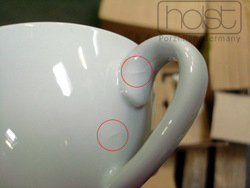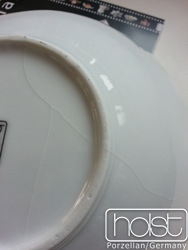Glaze-cracks

Glaze-cracks on porcelain
Glaze-cracks (due to production)
Production-related glaze cracks are small to medium-sized, clean, i.e. uncraqueled cracks that do not run through the whole piece, but only occur within the glaze itself, i.e. on the surface. Most of the time, these cracks appear at places where the glaze is a little thicker. Cracks in the glaze need not be visible immediately after production, they can still appear after years of use.
If the number of "hairline cracks" increases during use and if these cracks mainly change their width, the article is unlikely to be a porcelain article.
Glaze cracks (improper use)

Glaze cracks in porcelain are often confused with crackle-cracks. In contrast to cracklee, these features are not caused by a thermal but by a physical stress, which in turn is favoured by a thermal process. In most cases, glaze cracking occurs in dishwashing kitchens at the so-called contact points of stacked ware. They are often referred to by the observer as glaze cracks, although this is a classic cullet breakage. This "rinsing breakage" can be recognised by the fact that the course of the breakage is randomly visible without a recognisable pattern and that the body under the glaze has always been affected.
If several items of a model show similar damage in different places, this is a clear indicator that there is no defect in the article itself, but that the ware was stacked "ungentle" after the rinsing process. If such damaged items of crockery continue to be used, discoloration of the cullet will occur in the fine glaze cracks, which then blossom outwards. Please read our tip for users: commercial warewashing.
